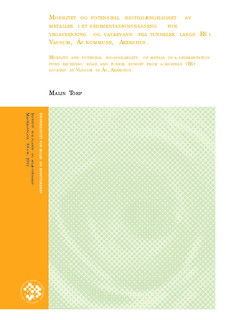| dc.description.abstract | Sediment columns from a sedimentation pond (located along highway E6, west of Oslo) receiving road runoff and tunnel wash water were taken out (October 2010) to perform a sequential extraction procedure, x-ray diffraction (investigating the clay fraction (<2m)) and determination of the total concentrations of elements (extracted with HF) in sediment and pore water (using ICPMS and ICPOES). The redox potential was measured in situ April 2011. Principal component analysis (PCA) was used to examine the pattern of extracted metals in sequential extraction. The aim was to assess the potential for remobilization and bioavailability of metals typically found in road runoff (mainly Cu, Cd, Zn, Pb and Sb) in the sediments and to investigate the depth profile. According to the classification system for polluted sediments provided by the Climate and Pollution Agency, the sediments were slightly polluted with Cd and Pb, and moderately to markedly polluted with Zn and Cu. There were significant differences (p<0,05) between all the layers (0-10, 10-20 and 20-30 cm) with respect to the total concentrations of metals. This may indicate transportation of metals downwards in the sediment or changes in water quality into the basin. Cadmium and Zn were predominant in the fraction of easily reduced material, where 51% of both metals were extracted. Copper was predominant in the easily oxidized material, where 72% was extracted. Pb was dominant in the residual fraction (metals extracted with HNO3), with 41% extracted. Copper, Pb, Zn and Cd are therefore susceptible to remobilization (not included the residual fraction) by changes in pH and redox potential, which can be caused by fluctuating water levels in the pond or changes in water quality. The metals are thus likely to switch to more labile fractions, and are thereby more likely to be bioavailable. The redox potential measured in sediments in situ suggests reducing conditions, and this may have caused an incorrect identification of some of the metals as a result of oxidation during the preparation and sequential extraction procedure. Antimony was dominant in the labile fractions, but HNO3 as an extractant is not sufficient to extract all Sb in the residual fraction, and the percentage of extracted Sb should be smaller in all other fractions. Statistical analysis of results from the PCA showed no significant differences between sediment layers with respect to the pattern of extracted metals (p>0,05), but significant differences can be seen between some of the metal fractions (p<0,05). No differences among layers may indicate the conditions downward the sediments are similar with respect to pH and redox potentials. Results from pore water analysis confirmed the content of several metals in the pore water typical for road runoff (Cr, Ni, Rh, Pd and Sb), indicating that these metals are potentially bioavailable. | no_NO |
